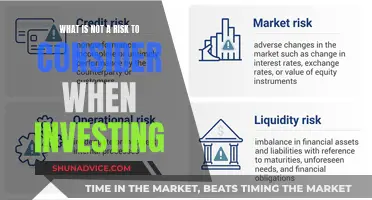
Investing is a great way to make your money work for you. It can be a smart financial move to build wealth over time and achieve financial goals. However, it's important to understand the basics of investing and the different investment options available.
There are various investment vehicles, such as stocks, exchange-traded funds (ETFs), mutual funds, bonds, real estate, and cryptocurrencies. Each option has its own risks and potential returns, so it's crucial to assess your financial situation, goals, and risk tolerance before deciding how to invest.
Additionally, it's important to consider the time horizon for your investments. Long-term goals, such as retirement, typically allow for a more aggressive and riskier investment strategy, while short-term goals require a more conservative approach.
By understanding your investment options, setting clear goals, and carefully assessing your risk tolerance, you can make informed decisions about how to invest your money to achieve your financial aspirations.
| Characteristics | Values |
|---|---|
| Investment style | Active (hands-on management) or passive (less effort) |
| Budget | Start with what you can afford |
| Risk tolerance | High or low |
| Investment types | Stocks, bonds, mutual funds, exchange-traded funds (ETFs), certificates of deposit (CDs), savings accounts, real estate, cryptocurrencies |
| Investment accounts | 401(k), traditional or Roth IRA, taxable brokerage account |
| Diversification | Reduce risk by investing in multiple asset classes |
What You'll Learn

Determine your risk tolerance
When determining your risk tolerance, it's important to understand your goals so you don't make a costly mistake. Your risk tolerance is the level of risk you are willing to take. It can be tricky to gauge your appetite for risk accurately. While risk can mean opportunity, excitement, or the potential for big gains, it also involves tolerating potential losses, the ability to withstand market swings, and the inability to predict what's ahead.
Behavioural scientists say "loss aversion" can colour your approach to risk – the fear of loss can play a bigger role in decision-making than the anticipation of gains. Since risk tolerance is determined by your comfort level with uncertainty, you may not become aware of your appetite for risk until faced with a potential loss.
Your risk tolerance depends on your goals, and your goals depend on your time horizon – when you plan to withdraw the money you've invested. In general, the longer your time horizon, the more risk you can assume because you have more time to recover from a loss. As you near your goal, you may want to reduce your risk and focus on preserving what you have.
Your risk capacity, or how much investment risk you can take on, is determined by your individual financial situation. This might include having a mortgage, your own business, kids approaching college age, or elderly parents who depend on you financially. A financial shock, like job loss or an accident that results in expensive medical bills, can also affect your investment decisions.
Your risk tolerance can be determined by asking yourself questions such as:
- How do you feel when you hear the word "risk" in relation to your finances? Does it make you feel excited about potential gains, or worried that you'll be left with nothing?
- What actions would you take after experiencing a significant investment loss?
- What decisions have you made in the past when the markets took a turn for the worse?
Your risk tolerance can also be influenced by your personality, age, and financial goals. If you are decades away from retirement, you may feel more comfortable taking risks because you have time to recover from any short-term market swings. However, those who are retired or about to retire may prefer to play it safer with a more conservative asset allocation.
- How many years do you have until retirement?
- What are you investing for? Do you have any specific investment goals aside from retirement?
- How do you feel about risk? How do you navigate uncertainty? Would you be able to handle significant losses?
Strategic Investment Managers: Guiding Principles for Financial Success
You may want to see also

Define your investment goals
Setting clear investment goals is a crucial step towards achieving financial success. Here are some detailed guidelines and considerations to help you define your investment goals effectively:
Understand the Basics and Your Current Situation
Before setting specific investment goals, it's important to understand the basics of investing and your current financial situation. This includes assessing your income, age, future outlook, risk tolerance, and financial commitments. Ask yourself why you want to invest. Are you planning for retirement, saving for a specific purchase, or pursuing financial independence? Being clear about your motivations will help guide your investment strategy.
Short-Term vs. Long-Term Goals
Investment goals can generally be categorised into short-term, mid-term, and long-term goals. Short-term goals typically refer to objectives you want to achieve within the next one to two years, such as saving for a new car or a renovation. Long-term goals, on the other hand, may take several years or even decades to accomplish, like saving for a new home, your children's education, or retirement. It's important to distinguish between these different time horizons as they will impact your investment strategies and the level of risk you're willing to take.
Be Realistic and Specific
When setting investment goals, it's essential to be realistic and specific. Avoid setting unrealistic expectations that may lead to disappointment. Make sure your goals are measurable and achievable within a reasonable timeframe. The SMART framework is a useful tool for setting effective goals:
- Specific: Clearly define what you want to achieve.
- Measurable: Establish criteria to track your progress.
- Achievable: Ensure your goals are attainable and practical.
- Relevant: Ensure your goals align with your life and are meaningful to you.
- Time-based: Assign a deadline to create a sense of urgency and track progress.
Risk Assessment and Tolerance
Understanding your risk tolerance is crucial when defining your investment goals. Assess how much risk you are comfortable taking. Consider your age, financial situation, and emotional tolerance for market volatility. Generally, longer-term investments can accommodate higher-risk strategies, while short-term goals may favour more conservative approaches. Diversification is also key—spread your investments across different asset classes to minimise the impact of market fluctuations.
Build an Investment Plan
Once you've defined your goals, create a detailed investment plan. This includes deciding on the types of investments you want to make, such as stocks, bonds, mutual funds, or real estate. Consider your risk tolerance, time horizon, and financial goals when constructing your portfolio. Seek professional advice if needed—a financial advisor can help you navigate the complexities of investing and ensure your plan aligns with your goals.
Regularly Review and Adjust
Markets are dynamic, and your investment plan should be flexible enough to adapt to changing conditions. Regularly review your investments to ensure they are performing as expected and making progress toward your goals. Be prepared to make adjustments along the way, whether it's changing your asset allocation, rebalancing your portfolio, or taking advantage of new investment opportunities.
Understanding Investment Management Fee Structures and Their Average Costs
You may want to see also

Choose an investment account
Choosing an investment account is a crucial step in building your financial future and achieving your goals. Here are some key considerations to help you select the right investment account:
Standard Brokerage Account:
A standard brokerage account, also known as a taxable brokerage account or non-retirement account, offers access to a wide range of investments, including stocks, mutual funds, bonds, and exchange-traded funds. Any earnings from these investments are subject to taxes in the year they are received. You can choose between an individual or joint taxable brokerage account, depending on your preferences and eligibility. A cash account is generally suitable for most investors, while a margin account allows you to borrow money from the broker for investments, which is a riskier option.
Retirement Accounts:
Retirement accounts, such as traditional IRAs, Roth IRAs, 401(k)s, and employer-sponsored plans, offer tax advantages. Traditional IRAs and 401(k)s provide upfront tax breaks, while Roth IRAs and Roth 401(k)s offer tax-free withdrawals during retirement. These accounts usually have contribution limits and may have penalties for early withdrawals.
Investment Accounts for Kids:
If you want to invest on behalf of a minor, you can consider a custodial brokerage account, such as a Uniform Gift to Minors Act (UGMA) or Uniform Transfers to Minors Act (UTMA) account. These accounts are controlled by an adult custodian and transferred to the child when they reach adulthood. UGMA accounts allow for a broader range of investments, including cash, stocks, bonds, and mutual funds, while UTMAs can also hold real estate.
Education Accounts:
Education accounts, like 529 savings plans, Coverdell Education Savings Accounts (ESAs), and ABLE accounts, are designed to save for education expenses. 529 plans are state-sponsored and offer tax-free withdrawals for qualified education costs. ESAs can be used for college, elementary, and secondary education expenses. ABLE accounts are specifically for individuals with disabilities, offering tax-advantaged savings for disability-related expenses while protecting access to public benefits.
General Investing Accounts:
If you prefer flexibility, a general investing account allows you to buy and sell whenever you want. However, you will need to pay taxes on your investment earnings.
When choosing an investment account, it's important to consider your financial goals, eligibility, tax implications, and the level of flexibility you require. Be sure to research the different options available and select the account that best aligns with your investment strategy and needs.
Individual Investment Strategies: A Guide to Making Personalized Investments
You may want to see also

Open your account
Opening an investment account is a relatively simple process, but it does require some research and consideration. Here is a step-by-step guide to opening an investment account:
Decide on the Type of Account:
Firstly, you need to decide on the type of account that suits your goals and financial situation. There are several options, including:
- Brokerage Account: This is a standard investment account offering flexibility and a wide range of investment options. Anyone over 18 can open one, and you can add money whenever you want. However, it is a taxable account, so you may have to pay taxes on any profits.
- 401(k) Plan: This is an employer-sponsored retirement plan, often offering tax benefits and the potential for employer-matched contributions.
- Individual Retirement Account (IRA): This is another tax-advantaged retirement account that you can open and manage yourself. It offers similar tax benefits to a 401(k) and provides more flexibility and control over your investments.
Choose a Brokerage Firm:
You will need to choose an online brokerage firm that suits your needs. Consider factors such as account minimums, fees, investment options, and the tools and resources they provide. Some popular options include Fidelity, Vanguard, and Charles Schwab.
Start the Application Process:
You will need to provide basic identification, tax, and income information to the broker. This typically includes personal information such as your name, address, Social Security number, and bank details. The application process is usually straightforward and can often be completed online within 30 minutes.
Fund Your Account:
Once your application is approved, you will need to transfer funds from your bank account to your brokerage account. This can usually be done through an online transfer, or you may have the option to send funds via wire transfer for an additional charge.
Practice Trading:
Before you start investing your money, it is important to understand the risks and practice your investing strategy. Many brokers offer simulated trading accounts or virtual trading platforms where you can learn the basics without risking your own money. Take advantage of these tools to familiarise yourself with the process and build your confidence.
Saving and Investment Economics: Core Concepts Explained
You may want to see also

Pick your investments
Picking your investments is a crucial step in achieving your financial goals. Here are some detailed guidelines to help you make informed decisions about your investments:
Create a Game Plan:
Before investing, it's essential to establish your time horizon and risk tolerance. Ask yourself, "How long do I plan to stay invested?" and "How much risk am I willing to take?" Understanding your time horizon will help you gauge the potential growth of your investments and your ability to withstand market fluctuations. Your risk tolerance, on the other hand, will guide you in choosing investments that align with your comfort level.
Choose Your Investments:
With your time horizon and risk tolerance in mind, you can explore various investment options such as stocks, bonds, exchange-traded funds (ETFs), and mutual funds.
- Stocks: Stocks represent ownership in a public company, and their prices fluctuate based on factors like company performance and news. Investing in stocks can be rewarding but is generally considered riskier. It's crucial to research individual stocks and diversify your portfolio to manage risk.
- Bonds: Investing in bonds is like lending money to companies or governments, which agree to repay with interest. Bonds are typically considered lower-risk investments and are assigned grades to help you understand the risk of the issuer defaulting.
- ETFs: Exchange-traded funds (ETFs) allow you to invest in a group of securities, such as stocks or bonds, at once. They provide diversification and are often created to follow a specific theme or category, such as a sector or market index. ETFs are considered less risky than individual stocks due to this diversification.
- Mutual Funds: Mutual funds pool money from multiple investors to purchase a collection of stocks, bonds, or other investments. Like ETFs, mutual funds spread your money across various investments and can be categorized based on the underlying assets. Mutual funds are actively managed by professionals and are traded only once a day at the end of the market day.
Buy Your Investments:
Once you've decided on the types of investments that align with your goals and risk tolerance, it's time to purchase those investments. Use your available cash or funds in your default money market account to invest in the options you've chosen. Remember that your risk tolerance, time horizon, and goals may change over time, so be prepared to adjust your investment plan accordingly.
Diversify Your Portfolio:
Diversification is a crucial aspect of investing. By allocating your investments across different asset classes, such as stocks, bonds, real estate, and more, you can manage risk and potentially increase your rewards. Diversification helps protect your portfolio from significant losses, as different asset classes tend to perform differently under various market conditions.
Additionally, consider your age and risk tolerance when determining the right mix of investments. Younger investors may opt for a higher proportion of stocks, while older investors may lean more towards bonds to reduce risk as they approach retirement.
Understand Key Investment Concepts:
There are several key concepts that can help guide your investment decisions:
- Dividends: Dividends are payments made by companies to their shareholders, usually from their profits. Dividends can boost your earnings and are often a sign of a healthy, established company.
- Price-Earnings (P/E) Ratio: The P/E ratio compares a company's current share price to its earnings per share. It indicates whether investors consider the stock expensive relative to its earnings and can help assess a stock's relative value.
- Beta: Beta measures the volatility of a stock compared to the overall market. A beta of 1 means the stock's volatility matches the market, while a beta above or below 1 indicates higher or lower volatility, respectively.
- Earnings Per Share (EPS): EPS represents the portion of a company's earnings allocated to each share of common stock. It helps investors gauge the company's ability to deliver value to shareholders, with higher EPS potentially leading to higher share prices.
Active vs. Passive Investing:
There are two main approaches to investing: active and passive. Active investing involves hands-on management, where you research and construct your portfolio independently. It requires time, knowledge, and a desire to actively manage your investments. Passive investing, on the other hand, is more hands-off, where you invest in vehicles managed by professionals or use automated investment platforms (robo-advisors). Passive investing generally requires less effort but may offer lower potential returns than active investing.
Attracting Investors: Strategies for Funding Your Startup
You may want to see also
Frequently asked questions
Before you start investing, you need to determine your budget and risk tolerance. You also need to decide on your investment style: active for hands-on management, or passive for less effort.
There are many ways to invest money, including stocks, bonds, mutual funds, exchange-traded funds (ETFs), certificates of deposit (CDs), savings accounts, and more. The best option for you depends on your particular risk tolerance and financial goals.
You can begin investing with as little as $100. The amount of money you're starting with isn't the most important thing. The big question is whether you're financially ready to invest and to invest frequently over time.







